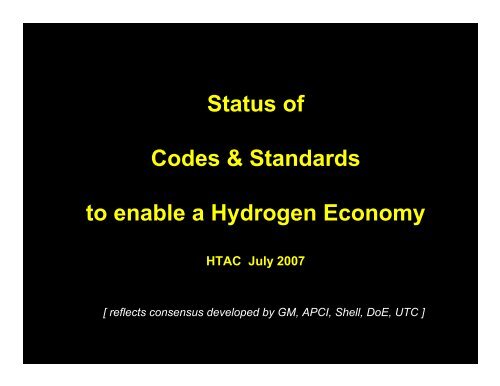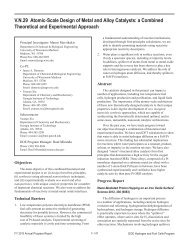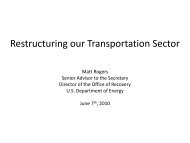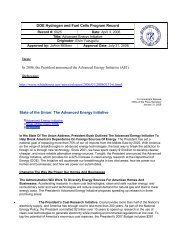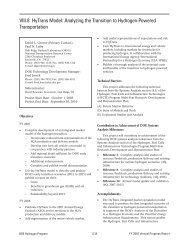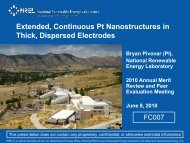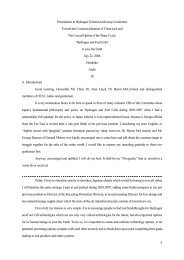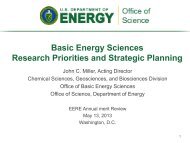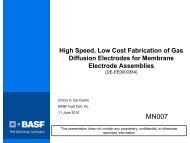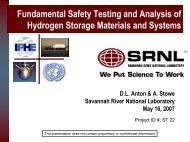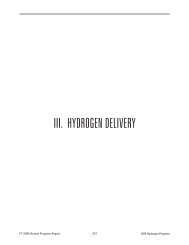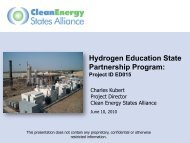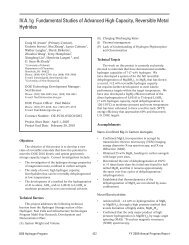PDF 308 KB - DOE Hydrogen and Fuel Cells Program Home Page
PDF 308 KB - DOE Hydrogen and Fuel Cells Program Home Page
PDF 308 KB - DOE Hydrogen and Fuel Cells Program Home Page
You also want an ePaper? Increase the reach of your titles
YUMPU automatically turns print PDFs into web optimized ePapers that Google loves.
Status of<br />
Codes & St<strong>and</strong>ards<br />
to enable a <strong>Hydrogen</strong> Economy<br />
HTAC July 2007<br />
[ reflects consensus developed by GM, APCI, Shell, DoE, UTC ]
Codes & St<strong>and</strong>ards<br />
St<strong>and</strong>ard<br />
-- a document with technical requirements <strong>and</strong> recommended practices<br />
Code<br />
-- a document which covers a broad range of facility requirements such as<br />
required safety systems, installation & monitoring requirements, <strong>and</strong> further<br />
safety provisions (e.g. separation distances, safety zone classifications, …)
Codes & St<strong>and</strong>ards<br />
St<strong>and</strong>ard<br />
-- a document with technical requirements <strong>and</strong> recommended practices<br />
• written for components or systems or combinations thereof<br />
• apply to design, service conditions, performance <strong>and</strong> validation testing<br />
• provide assurance of performance in normal <strong>and</strong> extreme conditions<br />
• established by SDOs (st<strong>and</strong>ard development organizations; e.g., ASME,<br />
ASTM, CGA, CSA, SAE, ISO…)<br />
• “listed” equipment Æ compliance verified by third party (UL, CSA…)<br />
Code<br />
-- a document which covers a broad range of facility requirements such as<br />
required safety systems, installation & monitoring requirements, <strong>and</strong> further<br />
safety provisions (e.g. separation distances, safety zone classifications, …)<br />
• can be adopted directly into law<br />
• refers to St<strong>and</strong>ards for requirements on equipment <strong>and</strong> systems<br />
• provide assurance of safety in normal <strong>and</strong> extreme conditions<br />
• established by CDOs (code development organizations; e.g., NFPA, ICC)<br />
• used as criteria for installation & operating permits by local AHJs<br />
(Authorities Having Jurisdiction) for stationary facilities
Over the last four years, we made significant progress<br />
… in adapting & establishing Codes for hydrogen facilities<br />
NFPA National Fire Protection Association: www.nfpa.org<br />
9 1: Uniform Fire Code<br />
• general fire code<br />
• includes provisions for presence of flammable gases<br />
9 2: <strong>Hydrogen</strong> Technologies Code (new)<br />
• collection of the requirements for hydrogen facilities in the<br />
multiple NFPA Codes<br />
9 52: Vehicular <strong>Fuel</strong> Systems Code<br />
• includes requirements for service facilities (repair of<br />
gaseous fuel systems)<br />
• includes requirements for non-OEM CHG vehicles<br />
9 55: Compressed Gas <strong>and</strong> Cryogenic Fluids<br />
• requirements for equipment, systems <strong>and</strong> siting of<br />
pressurized storage <strong>and</strong> fuel h<strong>and</strong>ling<br />
9 70: National Electric Code<br />
• general electrical code<br />
• includes provisions for presence of flammable gases<br />
95000: Building Construction <strong>and</strong> Safety Code<br />
• requirements for hydrogen storage <strong>and</strong> h<strong>and</strong>ling within<br />
buildings<br />
… effort needs to continue for another two years to get fully desired results<br />
(3-year revision cycle; ~2-year process for proposal adoption)
Over the last four years, we made significant progress<br />
… in harmonizing “competing” Codes for hydrogen facilities (HIPOC)<br />
ICC International Code Council: www.iccsafe.org<br />
9<br />
9<br />
9<br />
9<br />
IFC: International Fire Code<br />
• general fire code<br />
• includes provisions for presence of flammable gases<br />
• requirements for gas <strong>and</strong> liquid hydrogen supply systems<br />
IFGC: International <strong>Fuel</strong> Gas Code<br />
• hydrogen used as a fuel gas<br />
IBC: International Building Code<br />
• requirements for hydrogen storage <strong>and</strong> h<strong>and</strong>ling within<br />
buildings<br />
IMC: International Mechanical Code<br />
• piping requirements<br />
… <strong>and</strong> in harmonizing “competing” St<strong>and</strong>ards<br />
(stationary hydrogen storage & fuel systems, fuel dispensers, fueling stations, fuel<br />
quality, fuel flow & chemical measurements, component & system verification test<br />
methods …)
• New editions of NFPA & ICC Codes include hydrogen<br />
facilities<br />
-- most State Codes have not yet upgraded to the new editions.<br />
• Most AHJs are not aware of new hydrogen Codes <strong>and</strong>/or<br />
have no experience applying them<br />
Fire Code Adoption by State<br />
Air Products & Chemicals Inc.
What is Different from 10 years ago ?<br />
(siting of fueling stations)<br />
1990s –<br />
• C&S not written<br />
• AHJs without experience<br />
• Permit applicants without experience<br />
• Several years lead time for approval to begin construction<br />
2007 –<br />
• C&S established<br />
• AHJ training workshops initiated by <strong>DOE</strong> & State agencies<br />
• AHJs learn from track record of early facilities<br />
• Permit applicants<br />
• experience & lessons learned (documents & local needs; AHJs)<br />
• staff dedicated to duration of permit solicitation<br />
• ~1 year for approval to begin construction<br />
• Governments engaged in research & demonstrations to substantiate<br />
Code <strong>and</strong> St<strong>and</strong>ard revisions<br />
• Industry: expertise dedicated to Code & St<strong>and</strong>ard development &<br />
harmonization
What is Not Different?<br />
(targeted improvements)<br />
CODES & STANDARDS<br />
• Composite tanks not allowed in fueling stations<br />
• Instances of inappropriate carry-over of CNG<br />
requirements to CHG Codes<br />
• Odorization<br />
• Detection<br />
• Separation distances<br />
• Ground contamination<br />
• SAE/CSA & ISO St<strong>and</strong>ards for vehicle storage & fueling<br />
incomplete<br />
STATE AND FEDERAL REGULATIONS<br />
• Awaiting revision of State Building & Fire Codes<br />
• Awaiting establishment of federal requirements for portable<br />
hydrogen-fueled devices on airplanes<br />
• Awaiting revision of federal requirements for transport of<br />
hydrogen cargo<br />
• Awaiting UN-GTR/FMVSSs for vehicle safety
PRIORITIES<br />
• Training for permitting authorities & first responders<br />
• <strong>DOE</strong> training materials & experts<br />
• Availability of installed demonstration sites<br />
• Resource pool from companies involved in demonstrations<br />
• Managed liability while track record develops<br />
• Get components & systems listed to st<strong>and</strong>ards<br />
• Develop government constraints on liability
Challenge for Emergence of<br />
<strong>Hydrogen</strong> Economy<br />
= Experience not appreciated


